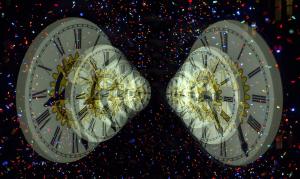Blog
Present and Past
22 July 2018
 Rodger Evans (CC BY-ND 2.0)
Rodger Evans (CC BY-ND 2.0)In our everyday lives, things seem to happen in a particular order. Things that happen to us seem to be triggered by earlier events. The upset stomach we have in the evening is caused by that third taco we had at lunch. Doing well on a final exam is thanks to studying the entire week before. Our life follows a series of causes and effects. But is it ever possible to go the other way around? Could an effect ever trigger a cause? In physics, this is known as retrocausality, and it could help us understand some of the deepest problems in modern physics.
One of the fundamental aspects of physics is that for basic interactions there isn’t an inherent order of cause and effect. If you observed a video showing the motion of two billiard balls as they collided, it would seem that their initial motion caused their eventual collision. But if you reversed the video, it would look as if the collision pushed the the balls away from each other. Without some other clue, you have no way of knowing which order is correct. There’s nothing in the laws of forces and collisions that tells you which version is the real one.
In more complex systems the order can be seen through entropy. Basically, entropy is a measure of the disorder of a system. So, if you watch a video where a cup falls and shatters into a dozen pieces, you know that’s the right direction of the video. Broken coffee cups don’t spontaneously fly together and jump up to land gently on a table. We know nudging the cup with your elbow caused it to fall and shatter.
But then there are cases where things get a bit more complicated, for example in delayed choice experiments. These are quantum experiments where you try to mix up the order of cause an effect. Quantum objects have an odd fuzziness to them, which means sometimes they can behave similar to particles, and sometimes they can seem to behave like waves. This doesn’t mean that quantum objects choose to become particles or waves, just that different properties show up in different kinds of experiments.
The classic example is a variation of the double slit experiment. Shine a beam of photons against a barrier with two slit openings. Left to their own devices, the photons take on a wave behavior, spreading through both slits and interfering with themselves to create a rippled pattern of light and dark on a more distant screen. In this case, there is no way to tell which slit the “particle” photon went through. But since photons are quantum objects, that doesn’t matter. They aren’t constrained to acting like a particle. But if you put a detector by each slit and measure which one each photon goes through, then the photons do have to behave like particles. When you do that, the rippled interference pattern goes away, and you just get two bright spots on the distant screen, as if the photons were particles all along.
But suppose you ran the experiment, measured which slit each photon passed through, and measured where each photon struck the distant screen, but before you look at the results, you destroy the data on which slit each photon passes through. In other words, you make a delayed choice about the experiment. What would happen? On the one hand, the measurements were made, so the photons should act like particles.
When this was first proposed as a thought experiment in the early 20th century, it caused a great deal of debate, but it wasn’t until 1999 that this kind of experiment was done.1 It didn’t involve a double slit, but it did involve choosing what is known about the photons after the experiment is committed. What we found was that the delayed choice really does determine the outcome of the earlier experiment. In our double slit experiment, that would mean destroying the data about the photons going through the slit would give the “wave” interference pattern, even though the “particle” data was collected at the time.
So it would seem that an effect could trigger a cause, and it is possible for the present to cause an outcome in the past. But things aren’t quite so clear. Not only do quantum objects have indefinite particle and wave properties, they can also do strange things like interacting in non-local ways. So the photons don’t have to violate causality for the delayed choice experiment to work. What experiments like these do show is that the universe is complicated, and what’s obvious in our every day experience might not be how the universe really works.
Kim, Yoon-Ho; R. Yu; S.P. Kulik; Y.H. Shih; Marlan Scully (2000). A Delayed ‘Choice’ Quantum Eraser. Physical Review Letters. 84: 1–5. ↩︎